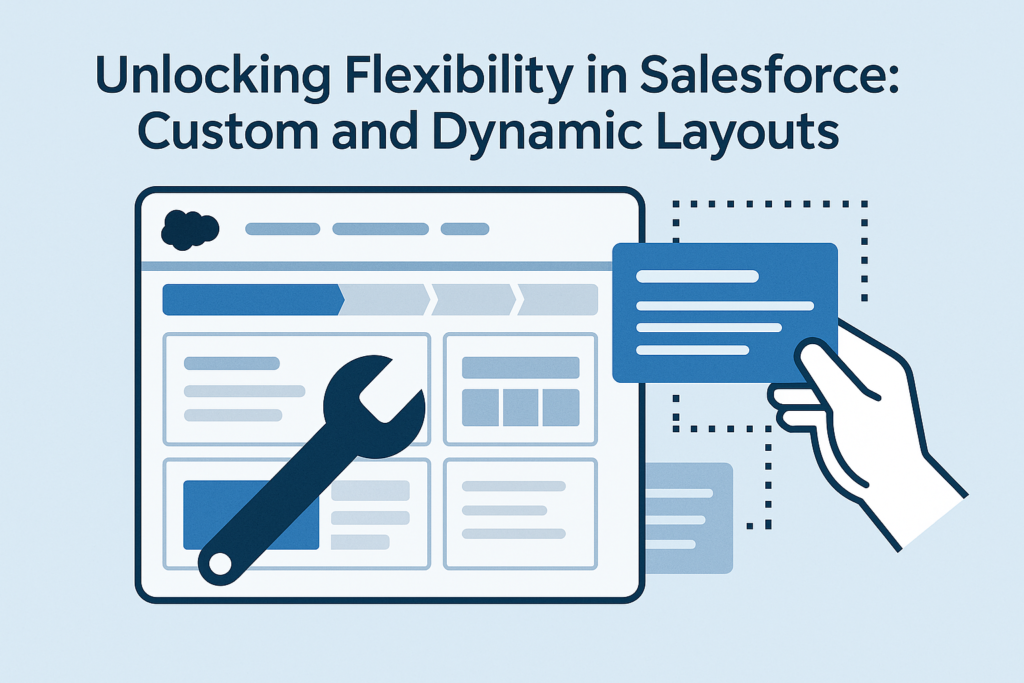Unlocking Flexibility in Salesforce: Custom and Dynamic Page Layouts
In today’s fast-paced business environment, user experience is critical for productivity. Salesforce, being a leading CRM platform, offers powerful ways to customize how users interact with data through Custom and Dynamic Page Layouts. These features ensure that users see exactly what they need, when they need it, streamlining workflows and improving adoption.
What Are Page Layouts in Salesforce?
Page layouts in Salesforce define the structure of a record’s detail page. They control which fields, related lists, buttons, links, and other components are visible and editable. Traditionally, page layouts were static — the same layout applied to all users assigned to a particular profile.
While this approach works for simple organizations, it lacks flexibility for companies with diverse teams, roles, or processes. This is where custom and dynamic page layouts come into play.
Custom Page Layouts: Tailored for Specific Needs
A custom page layout allows you to design a page specifically for a profile or record type. Salesforce admins can:
- Rearrange fields: Group related information together for better readability.
- Control visibility: Make certain fields required or read-only depending on the profile.
- Manage related lists: Show only the related lists relevant to the user’s role.
- Add quick actions: Place the most commonly used actions upfront for efficiency.
Benefits of Custom Page Layouts
- Improved User Experience: Each user sees only what is relevant, reducing clutter and confusion.
- Better Data Accuracy: Required fields ensure critical information is captured.
- Streamlined Processes: Quick actions and tailored layouts accelerate workflows.
Example:
A sales rep might need a layout showing Opportunities, Contacts, and Account details prominently, while a support agent’s layout prioritizes Cases, Assets, and Service History.
Dynamic Page Layouts: The Next Level of Flexibility
While custom layouts are profile-based, dynamic layouts allow the interface to change in real-time based on conditions such as record field values or user roles. Salesforce offers this functionality through Dynamic Forms and Dynamic Actions.
Dynamic Forms
Dynamic Forms let you move fields and sections from the page layout to the Lightning record page, giving unprecedented control over field visibility:
- Fields can be shown or hidden based on record data (e.g., show the “Renewal Date” field only for active contracts).
- Sections can collapse or expand depending on conditions.
- Admins can reduce clutter and focus users on critical data.
Dynamic Actions
Dynamic Actions let you control which actions (buttons) are available depending on context:
- Only show “Approve” for managers or “Close Case” when the status is “Pending.”
- Remove unused actions for specific users or roles.
Benefits of Dynamic Page Layouts
- Contextual Experience: Users see relevant fields and actions based on the current scenario.
- Reduced Errors: Fields irrelevant to the current context are hidden, reducing the chance of incorrect data entry.
- Enhanced Productivity: Fewer distractions mean faster and more efficient workflows.
Example:
In a service scenario, if a case’s priority is “High,” a section with escalation instructions and related actions could automatically appear for the agent.
Implementing Custom and Dynamic Page Layouts in Salesforce
- Identify user requirements: Determine what different roles or processes need to see.
- Set up record types: Use record types to differentiate layouts for different business processes.
- Create page layouts: Design profile-specific layouts to optimize visibility and usability.
- Enable Dynamic Forms: Convert standard page layouts to dynamic forms to control field visibility.
- Configure Dynamic Actions: Add context-sensitive actions to streamline user workflows.
- Test and iterate: Validate the layout with actual users and refine based on feedback.
Best Practices
- Use Dynamic Forms for complex objects with many fields to reduce clutter.
- Avoid overloading layouts — keep them simple and intuitive.
- Combine record types and dynamic visibility rules for maximum flexibility.
- Regularly review layouts as business processes evolve.
Conclusion
Custom and dynamic layouts in Salesforce empower organizations to create role-specific, context-sensitive experiences. By combining these capabilities, Salesforce admins can deliver highly efficient interfaces that improve user productivity, reduce errors, and enhance CRM adoption.
Salesforce is no longer just about managing data — it’s about delivering the right experience to the right user at the right time. Custom and dynamic layouts make that possible.

